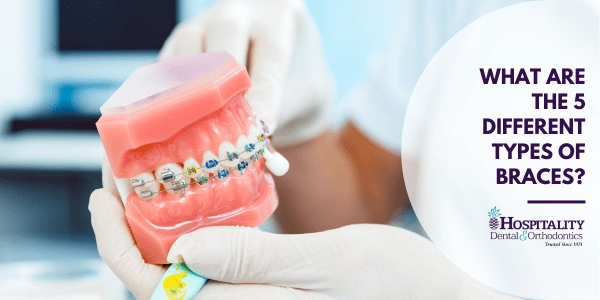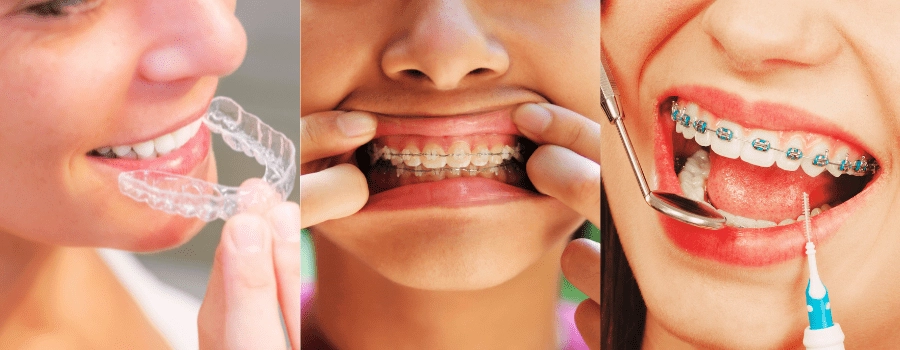
Braces can only be applied by a certified dental professional – this is most often an orthodontist; dentists can only apply braces in specific circumstances. And when a patient has braces put in, it’s for one of two reasons.
Braces for Cosmetic Purposes
Crooked teeth can be straightened if someone’s smile lacks confidence. Many people associate braces with children and teens, but they can be worn at any age. In fact, 20% of all orthodontic patients are over 18. Research has shown that straighter teeth can significantly boost self-esteem and quality of life, and that’s something that can benefit people of any age.
Braces for Health Purposes
There are a number of mouth issues that can make it difficult to chew food properly, speak clearly, and maintain oral hygiene. Each one of these health issues can compound to create further distress. For example, an inability to properly chew food could lead to digestive problems.
The following conditions could all lead to a health-related need for braces:
- Overbite
- Underbite
- Crossbite
- Open bite
- Crowded teeth
- Gaps between teeth
The Five Types of Braces

Once an orthodontist has suggested a patient could benefit from braces, they will consult together on which of the five types of braces is the best fit.
Metal Braces
Metal braces are the most traditional option, though they have thankfully benefitted from technology that has made them smaller, more comfortable, and more effective than the bulky gear of the past.
Metal braces use a wire and a series of elastic ties to move the teeth into the desired position, with an orthodontist adjusting the wire every 4-8 weeks.
Metal Braces Pros
- Efficient and effective for a variety of conditions
- Does not alter speech
- Most affordable option
- Very durable
Metal Braces Cons
- Most noticeable due to wires and brackets
- Requires oral hygiene diligence
- Requires frequent adjustments
- Adjustments can irritate cheeks and lips
Ceramic Braces
Some people call ceramic braces “clear braces,” because they function in exactly the same way as metal braces, except the brackets are tooth-colored rather than metal.
Ceramic Braces Pros
- Less noticeable
- Equally effective and versatile as traditional metal braces
Ceramic Braces Cons
- More expensive than metal braces
- “Tooth-colored” brackets can stain over time
- More fragile than metal and at risk of breaking
Self-Ligating Braces
Self-ligating braces are very similar to metal braces and ceramic braces – in fact, these orthodontics are available both in metal and clear/ceramic styles. But rather than using elastic bands to move the wire, self-ligating braces use specialized doors and clips.
Self-Ligating Braces Pros
- May require fewer adjustments
- May reduce time needed for adjustments, potentially benefitting those with sensory conditions or developmental delays
Self-Ligating Braces Cons
- More expensive than traditional (elastic band) metal braces
- May not be an option for all cases
Lingual Braces
Lingual braces are much like traditional metal braces, but the brackets are attached to the rear of a patient’s teeth. These are often applied when a patient wants to conceal the fact that they have braces.
Lingual Braces Pros
- Completely invisible from the front
Lingual Braces Cons
- Most expensive option
- May initially cause speech impediments
- Can irritate the tongue
- Difficult to clean
Clear Aligners
The latest technology in orthodontics is the clear aligner, a discreet and removable option for adjusting your teeth and bite. This can be an especially attractive option for patients who have the strong self-discipline to make sure the devices are being worn for the time prescribed.
Clear Aligners Pros
- Nearly invisible
- Removable for dining
- Removable for regular oral hygiene and device cleaning
- Often more comfortable than traditional braces
Clear Aligners Cons
- Not suitable for more complex cases
- Discipline required!
- Can be more expensive than other options
Now that you’re “armed to the teeth” with information about braces, you can make a more informed decision with your orthodontist about what type of braces is the best for you. If you’re in the California area, request a consultation at the nearest Hospitality location!
